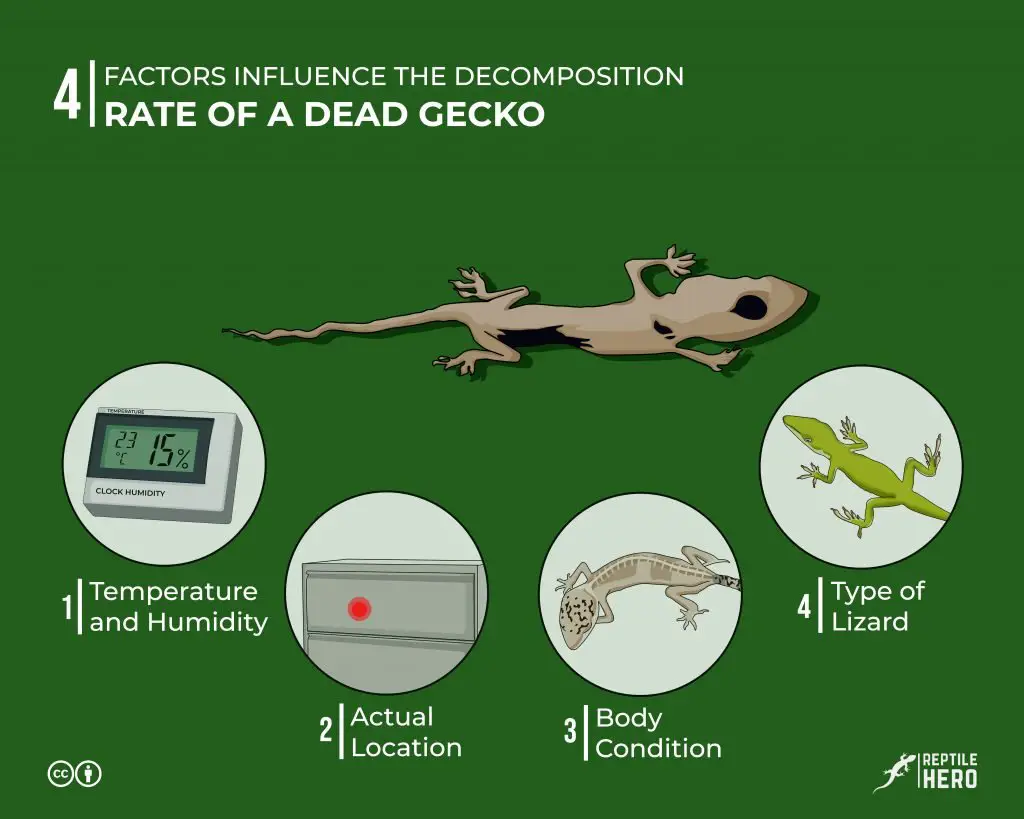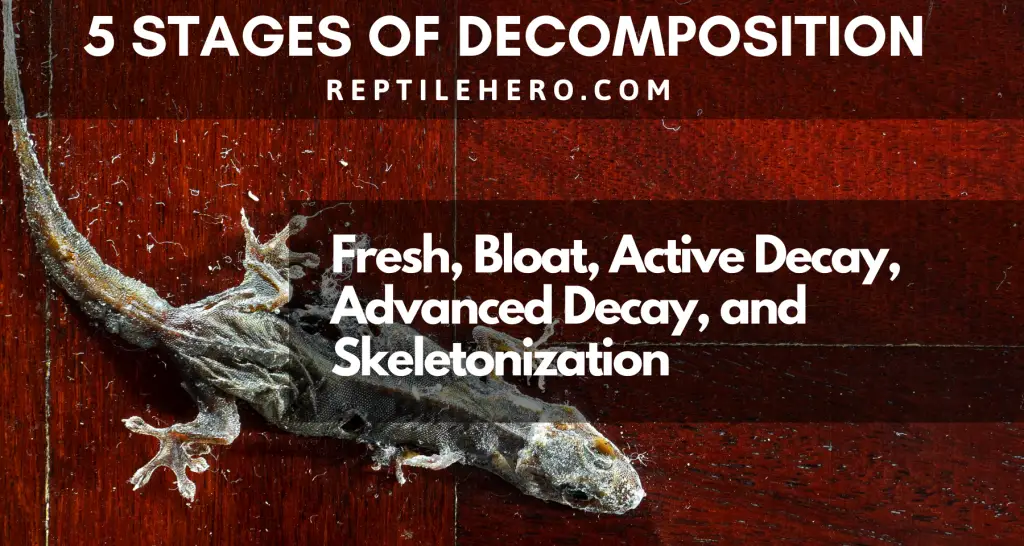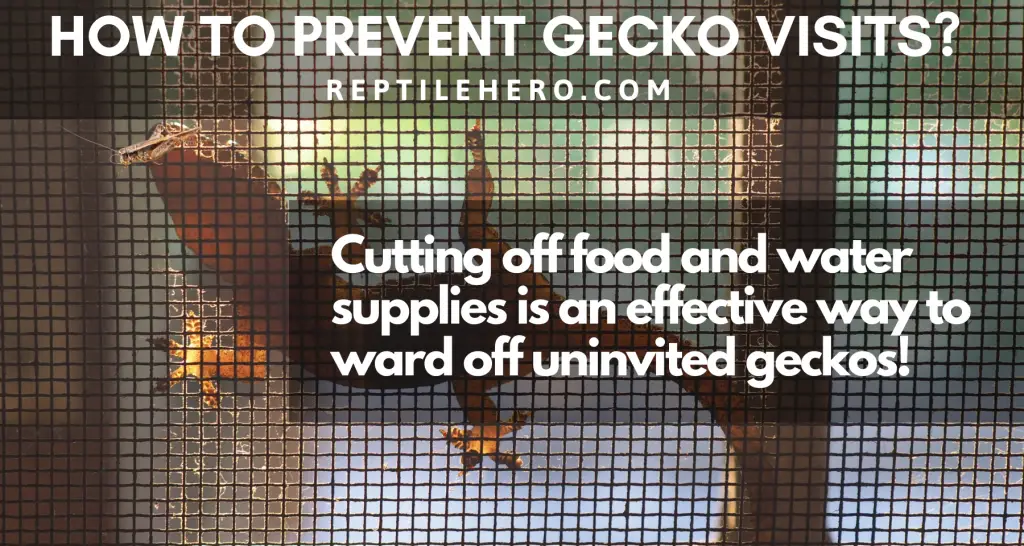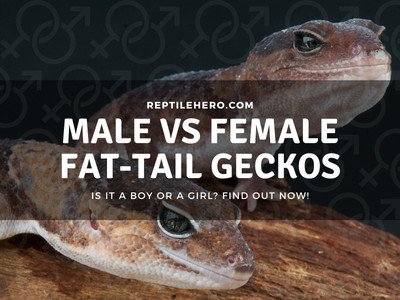How Fast Does A Gecko Decompose? [4 Factors]
Have you had any daunting experience dealing with wild geckos entering your house? Are you one of the people who have accidentally squashed a hiding lizard between seams of doors and windows? Have you ever wondered how long it would take for it to decay?
Generally, a wild gecko entering a house takes around 23 days to fully decompose after it dies. This is true especially for the Asian House Gecko, the most common wild geckos that invade American homes. Four factors influence the decomposition rate of a dead wild gecko:
- Temperature and Humidity
- Actual location
- Body condition
- Type of lizard
To know more about this topic, keep on scrolling!
How Long Does A Gecko Decay?
It may be atypical for you to see a wild leopard gecko basking outside your lawn or a crested gecko resting atop your tree branches. However, another gecko species are frequent uninvited guests at your house. You might already have even had coincidental rendezvous with each other!
An Uninvited Guest: Asian House Geckos

Asian House Geckos (Hemidactylus frenatus) are natively found in tropical and subtropical regions of Asia. You might find this weird. But this lizard species cohabitate with locals in urban and rural areas, unlike other geckos that prefer to avoid human interactions [1].
In the United States, both accidental and deliberate introduction of the species have created a stable and settled species population. They have even successfully invaded portions of California, Florida, and Texas, to name a few [2].
With their growing distribution across the country, Asian House Geckos have become regular sightings, gathering around public light fixtures at night. It is not even uncommon that, attracted by indoor lights, they invade houses for shelter and repair!
Other people welcome them as suitable pest controllers—eating small insects and keeping their population at bay. Meanwhile, some people view them as pests that must be exterminated. No worries, I will not judge you if you are one of them. I feel the same way for pesky rats and cockroaches.
How long it would take for a spattered wild gecko to decay inside a house?
A wild gecko, such as the Asian House Gecko, may take around 23 days to fully decompose to its bones following the natural decaying process.
Are you curious about how the decomposition took place? Check the video below to see a time-lapse of the decaying process.
What Are The Factors Affecting The Rate of Decay?
The four factors that directly affect the rate of decay are:
- Temperature and Humidity
- Actual location
- Body condition
- Type of lizard
Once a gecko dies either from an accident or a natural cause, decomposition begins quite rapidly soon after. However, as to the rate of the process, you may have to take a lucky guess as these four conditions play a vital role in how long it takes place.
1. Temperature and Humidity
The decomposition of the gecko’s body is greatly affected by air circulation, humidity level, and temperature.
A well-ventilated area with a scorching and arid condition completely dries up the body into a crispy carcass, making the decomposition of the body very fast.
As a matter of fact, these conditions could actually hasten the drying time into less than half the ambient conditions. To the extent, the dried body could not even further decompose.
Conversely, the opposite is true if you find the gecko’s body where the air is damp and the environment is cool and unventilated. If it were to dry up, the body could take twice as long as in the average room conditions. In some cases, drying could fail to ultimately occur. So, you might even see the carcass proceeding to further decay!
2. Actual Location
While it is true that the location’s weather conditions have a huge impact, the actual location of the gecko’s carcass also affects the rate just as much. Do you want to know why?
The actual location influences the decomposition rate by the access of insects and scavengers to the body. In a well-hidden area like inside the drawer’s cabinet, the carcass could take longer to decay. Until one of the scouting ants finds the body and informs the rest of the army can the process fully progress.
The presence of ants in a house, especially a few days after seeing a wild gecko in it, might indicate that the animal died. Following the ant’s trail might be an excellent solution to locate the wild gecko carcass.
Meanwhile, a sticking carcass on the wall of your balcony is more exposed to different insects and scavengers. However, not for a long while, as you might immediately see flies or other bugs feasting over the gecko’s body.
Do you have a wild guess on how long it would take for an army of ants to clean a gecko’s carcass? Let me show you this rare footage of how fast they can do it!
3. Body Condition
The state of the gecko’s body could also accelerate or delay the decomposition from the usual rate.
If a wild gecko enters your house and gets lost along the way, it could die due to starvation and dehydration. Though its body could become skinny, it would still be intact—free from any physical injuries. When this happens, the body would naturally proceed to decomposition. Unless other factors are taken into account, you should expect an average decay rate of about a month.
On the other hand, when a wild gecko dies of traumatic wounds, the body would incur damages. It may sound morbid to you, but the abrasions, cuts, lesions, and ulcers could emit an appetizing scent to predators. And immediately, you would see bugs and other insects decaying it much faster.
4. Type of Lizard
Lizards come in various sizes, and their physical structure affects the rate at which their body decomposes. Urban settlers like you would most likely experience the smaller ones—like anoles and geckos—invade your homes.
Typical trespassing lizards, such as Asian House Geckos, will naturally decay around 23 days (more than three weeks) in ambient conditions. And you may not always observe the usual stages of decomposition. As several factors come into play, the process could be at times indiscriminate. Eventually, you might just end up setting foot on the bones of the remains.
Although it is unbelievable for larger species such as Gila monsters (Heloderma suspectum) and Komodo dragons (Varanus komodoensis) to intrude your metro life, do you want to know how long it would take for these massive lizards to decay?
Before checking this video out, I am warning you that the clip contains some graphic decomposition images. So, watch at your own risk!
What Are The Stages Of Decomposition?
The experiment in the Savannah monitor lizard clearly depicted the different stages of animal decomposition in a controlled setting. In the wild, decomposition is the stepping stone of recycling used nutrients for future purposes [3].
The five stages of decomposition are:
- Fresh
- Bloat
- Active decay
- Advanced decay
- Skeletonization
If you found the video too graphic, let me briefly explain the five stages in words.
Stage 1 – Fresh
- The lizard carcass attracts different species of flies.
- House flies (Muscidae) and blowflies (Calliphoridae) lay eggs.
- Maggots hatch from the eggs after 24 hours.
Stage 2 – Bloat (Autolysis)
- Microbes (bacteria) multiply and respire.
- Skin ruptures as a result of anaerobic respiration (decay in the absence of air).
- The gases are characterized by their bad smell.
- The carcass deflates as the gases escape.
Stage 3 – Active Decay (Putrefaction)
- Maggots proliferate.
- They consume much of the soft tissue.
- The moist carcass loses mass rapidly.
After two weeks, the hosts introduced dermestid beetles (larder beetles) to the decomposing body.
Stage 4 – Advanced Decay
- Dermestid beetles and microbes clean the remaining skeleton.
- At this point, the parasites enter to take over the decomposition process.
After four and a half weeks, the hosts rechecked the room. They noticed the strong foul smell continued to persist. Also, the maggots have turned into flies.
Stage 5 – Skeletonization
- Beta-keratin in the lizard’s skin remains.
- A dry skeleton of bones is left.

2 Signs Of A Dead Gecko In a House
If your gut instincts tell you that there is a dead gecko inside your house, you must verify this claim by looking for these two signs: 1) foul odor and 2) insects and bugs.
1. Foul Odor
The presence of foul-smelling gases that is distinct and hard to ignore is a clear indication of a decomposition process in due course.
Some would say that the disgusting smell is like a rotten egg, while others think it is like a “cheesy foot.” Actually, the odor is hard to describe and put into words. However, once you smell it, it is hard to ignore. So, this makes a helpful sign that a dead gecko is somewhere in your house.
The size of the lizard also matters. A typical Asian House Gecko can produce a distinct and noticeable smell despite its small size. Also, its strength depends on how long it has been decomposing.
The development of the lingering foul odor could progress as follows:
- Day 1: After the gecko dies, you might not smell anything weird yet.
- Day 2: You may already noticed something odd smells in your house.
- Day 3 or 4: The foul odor would become unbearable.
- Day 14: You may notice that the scent is weakening.
- Day 21: The foul odor may have already subsided.
You should note that these are subject to change, depending on the nature and cause of death. However, as long as the carcass is still decomposing, it would continue emitting a strong odor.
If you do not remove the gecko’s carcass, you would have to bear the intolerable scent until it naturally goes away. In case you are eager, you can use this to guide you in locating its body.
To remove the unpleasant odor of a dead gecko inside a house you should:
- Remove the gecko’s carcass.
- Dispose of it accordingly.
- Disinfect the area properly.
- Treat the area with odor neutralizer.
- Mask up the smell with another fragrance.
- Ventilate the area with a fan out the windows.
2. Crawling Critters
Typically, for an Asian House Gecko, it is unlikely that you would find large predators—like crows or vultures—enjoying themselves over the body. So, you should rely on the presence of crawling critters like insects.
The gecko’s foul odor attracts different household insects—in particular ants. One of the most effective ways to track the carcass is following the trail of ants. Without a doubt, you would find the gecko’s body at the end of the track in no time!
However, you have to be ready yourself. Other insects, such as flies and cockroaches, may already be at the scene of the crime upon discovery, feasting over the carcass!
How To Prevent Geckos In Your House?
Even though an unwelcome guest like a harmless Asian House Gecko enters your house, you can get rid of it without necessarily taking its life. Nevertheless, doing the act and dealing with it is a hassle altogether. So, the best way for you is to prevent it from seeking shelter in your home.
Here are four ways you can follow to prevent geckos from entering your house:
- Cut out their food supply by getting rid of ants, cockroaches, and spiders.
- Cut out their water supply by draining and wiping accumulated water.
- Seal all the gaps, seams, and other potential entry points.
- Use repellants like naphthalene balls inside cabinets.

Takeaways
Although the species are not native to the United States, Asian House Geckos are wild geckos that typically invade American households.
Even though the length of time varies, carcasses of Asian House Geckos usually decompose around 23 days.
The decomposition rate of gecko carcasses is directly affected by four factors: 1) weather, 2) environment, 3) body condition, and 4) type of lizard.
The five stages of decomposition are fresh, bloat, active decay, advanced decay, and skeletonization. The stages are more distinguishable in carcasses of larger lizards than in smaller ones like Asian House Geckos.
Two signs can be used to verify a gecko carcass around the house: 1) a foul odor and 2) the presence of crawling critters.
Sources
[1] https://animaldiversity.org/accounts/Hemidactylus_frenatus/#A7BCF3A3-C23D-11E6-8FEE-A820662394EA
[2] http://www.tsusinvasives.org/home/database/hemidactylus-frenatus
[3] https://treesforlife.org.uk/into-the-forest/habitats-and-ecology/ecology/decomposition-and-decay/



![What Do Gecko Eggs Look Like? [Size, Color, and More]](https://www.reptilehero.com/wp-content/uploads/2021/03/word-image-25-768x576.png)
![3 Reasons Why Your Gecko Smells Bad [and 7 Tips]](https://www.reptilehero.com/wp-content/uploads/2021/04/G34_2-1-768x614.jpg)

![Gecko Alone While On Vacation? [7 Things To Check]](https://www.reptilehero.com/wp-content/uploads/2022/03/gecko-alone-cc-1-768x614.jpg)
